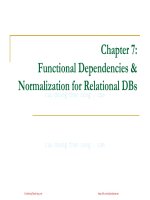cơ sở dữ liệu lê thị bảo thu chương ter c5 concurrency control sinhvienzone com
Bạn đang xem bản rút gọn của tài liệu. Xem và tải ngay bản đầy đủ của tài liệu tại đây (809.2 KB, 57 trang )
Chapter 5
Concurrency Control Techniques
Adapted from the slides of “Fundamentals of Database Systems” (Elmasri et
al., 2006)
CuuDuongThanCong.com
/>
Chapter Outline
Purpose of Concurrency Control
Two-Phase Locking Techniques
Concurrency Control Based on Timestamp
Ordering
Multi-version Concurrency Control Techniques
Validation (Optimistic) Concurrency Control
Techniques
Granularity of Data Items And Multiple Granularity
Locking
CuuDuongThanCong.com
/>
2
1. Purpose of Concurrency Control
To enforce Isolation (through mutual exclusion)
among conflicting transactions.
To preserve database consistency through
consistency preserving execution of
transactions.
To resolve read-write and write-write conflicts.
Example:
In concurrent execution environment: if T1 conflicts with T2
over a data item A
Then the concurrency control decides if T1 or T2 should
get the A and if the other transaction is rolled-back or waits.
CuuDuongThanCong.com
/>
3
2. Two-Phase Locking Techniques (1)
Locking is an operation which secures
Example:
Lock (X). Data item X is locked in behalf of the requesting
transaction.
Unlocking is an operation which removes these
permissions from the data item.
Example:
(a) permission to Read
(b) permission to Write a data item for a transaction.
Unlock (X): Data item X is made available to all other
transactions.
Lock and Unlock are Atomic operations.
CuuDuongThanCong.com
/>
4
Two-Phase Locking Techniques (2)
Database requires that all transactions
should be well-formed. A transaction is wellformed if:
It must lock the data item before it reads or
writes to it.
It must not lock an already locked data items
and it must not try to unlock a free data item.
CuuDuongThanCong.com
/>
5
Two-Phase Locking Techniques (3)
Type of Locks:
Binary Locks
Shared/ Exclusive (or Read/ Write) Locks
CuuDuongThanCong.com
/>
6
Two-Phase Locking Techniques (4)
Binary Locks
2 values: locked and unlocked (1 and 0)
The following code performs the lock operation:
B: if LOCK (X) = 0 (*item is unlocked*)
then LOCK (X) 1 (*lock the item*)
else begin
wait (until lock (X) = 0) and
the lock manager wakes up the transaction);
goto B
end;
CuuDuongThanCong.com
/>
7
Two-Phase Locking Techniques (5)
Binary Locks
The following code performs the unlock operation:
LOCK (X) 0 (*unlock the item*)
if any transactions are waiting then
wake up one of the waiting the transactions;
CuuDuongThanCong.com
/>
8
Two-Phase Locking Techniques (6)
Binary Locks
Rules:
1. A transaction T must issue the operation lock_item(X)
before any read_item(X) or write_item(X) operations in T.
2. A transaction T must issue the operation unlock_item(X)
after all read_item(X) and write_item(X) operations are
completed in T.
3. A transaction T will not issue a lock_item(X) operation if it
already holds the lock on item X.
4. A transaction T will not issue an unlock_item(X) operation
unless it already holds the lock on item X.
CuuDuongThanCong.com
/>
9
Two-Phase Locking Techniques (7)
Shared/ Exclusive (or Read/ Write) Locks
Two locks modes:
(b) exclusive (write).
Shared mode: read lock (X)
(a) shared (read)
More than one transaction can apply share lock on
X for reading its value but no write lock can be
applied on X by any other transaction.
Exclusive mode: write lock (X)
Only one write lock on X can exist at any time and
no shared lock can be applied by any other
transaction on X.
CuuDuongThanCong.com
/>
10
Two-Phase Locking Techniques (8)
Shared/ Exclusive (or Read/ Write) Locks
Lock Manager:
Managing locks on data items.
Lock table:
Lock manager uses it to store the identify of transaction
locking a data item, the data item, lock mode and pointer
to the next data item locked. One simple way to
implement a lock table is through linked list.
Transaction ID Data item id lock mode Ptr to next data item
T1
X1
Read
Next
CuuDuongThanCong.com
/>
11
Two-Phase Locking Techniques (9)
Shared/ Exclusive (or Read/ Write) Locks
The following code performs the read lock operation:
B: if LOCK (X) = “unlocked” then
begin LOCK (X) “read-locked”;
no_of_reads (X) 1;
end
else if LOCK (X) “read-locked” then
no_of_reads (X) no_of_reads (X) +1;
else begin wait (until LOCK (X) = “unlocked” and
the lock manager wakes up the transaction);
go to B;
end;
CuuDuongThanCong.com
/>
12
Two-Phase Locking Techniques (10)
Shared/ Exclusive (or Read/ Write) Locks
B:
The following code performs the write lock operation:
if LOCK(X) = “unlocked”
then LOCK(X) ← “write-locked”
else begin
wait (until LOCK(X) = “unlocked”
and the lock manager wakes up the transaction);
go to B
end;
CuuDuongThanCong.com
/>
13
Two-Phase Locking Techniques (11)
Shared/ Exclusive (or Read/ Write) Locks
The following code performs the unlock operation:
if LOCK (X) = “write-locked” then
begin LOCK (X) “unlocked”;
wakes up one of the transactions, if any
end
else if LOCK (X) “read-locked” then
begin
no_of_reads (X) no_of_reads (X) -1
if no_of_reads (X) = 0 then
begin
LOCK (X) = “unlocked”;
wake up one of the transactions, if any
end
end;
CuuDuongThanCong.com
/>
14
Two-Phase Locking Techniques (12)
Shared/ Exclusive (or Read/ Write) Locks
Rules:
1. A transaction T must issue the operation read_lock(X)
or write_lock(X) before any read_item(X) operation is
performed in T.
2. A transaction T must issue the operation write_lock(X)
before any write_item(X) operation is performed in T.
3. A transaction T must issue the operation unlock(X)
after all read_item(X) and write_item(X) operations are
completed in T.
CuuDuongThanCong.com
/>
15
Two-Phase Locking Techniques (13)
Shared/ Exclusive (or Read/ Write) Locks
Rules (cont.):
4. A transaction T must not issue a read_lock(X)
operation if it already holds a read(shared) lock or a
write(exclusive) lock on item X.
5. A transaction T must not issue a write_lock(X)
operation if it already holds a read(shared) lock or a
write(exclusive) lock on item X.
6. A transaction T must not issue the operation unlock(X)
unless it already holds a read (shared) lock or a
write(exclusive) lock on item X.
CuuDuongThanCong.com
/>
16
Two-Phase Locking Techniques (14)
Shared/ Exclusive (or Read/ Write) Locks
Lock conversion
Lock upgrade: existing read lock to write lock
if Ti has a read-lock (X) and Tj has no read-lock (X) (i j) then
convert read-lock (X) to write-lock (X)
else
force Ti to wait until Tj unlocks X
Lock downgrade: existing write lock to read lock
Ti has a write-lock (X) (*no transaction can have any lock on X*)
convert write-lock (X) to read-lock (X)
CuuDuongThanCong.com
/>
17
Two-Phase Locking Techniques (15)
Two-Phase Locking
Two Phases:
(a) Locking (Growing)
(b) Unlocking (Shrinking).
Locking (Growing) Phase:
A transaction applies locks (read or write) on desired data
items one at a time.
Unlocking (Shrinking) Phase:
A transaction unlocks its locked data items one at a time.
Requirement:
For a transaction these two phases must be mutually
exclusively, that is, during locking phase unlocking phase
must not start and during unlocking phase locking phase must
not begin.
CuuDuongThanCong.com
/>
18
Two-Phase Locking Techniques (16)
Two-Phase Locking
CuuDuongThanCong.com
/>
19
Two-Phase Locking Techniques (17)
Two-Phase Locking
CuuDuongThanCong.com
/>
20
Two-Phase Locking Techniques (18)
Two-Phase Locking
T1’ and T2’ follow
two-phase policy
but they are subject
to deadlock, which
must be dealt
with.
CuuDuongThanCong.com
/>
21
T’1
T’2
read_lock (Y);
read_item (Y);
write_lock (X);
read_lock (X);
unlock (Y);
read_item (X);
X:=X+Y;
write_item (X);
unlock (X);
wait
read_lock (X);
read_item (X);
write_lock (Y);
unlock (X);
read_item (Y);
Y:=X+Y;
write_item (Y);
unlock (Y);
CuuDuongThanCong.com
Guaranteed to be
serializable
/>
22
T’1
T’2
read_lock (Y);
read_item (Y);
Deadlock
read_lock (X);
read_item (X);
write_lock (X);
write_lock (Y);
unlock (X);
read_item (Y);
Y:=X+Y;
write_item (Y);
unlock (Y);
unlock (Y);
read_item (X);
X:=X+Y;
write_item (X);
unlock (X);
CuuDuongThanCong.com
Can produce a deadlock
/>
23
Two-Phase Locking Techniques (19)
Two-Phase Locking
Variations:
(a) Basic
(b) Conservative
(c) Strict
(d) Rigorous
Conservative:
Prevents deadlock by locking all desired data items
before transaction begins execution.
Basic:
Transaction locks data items incrementally. This
may cause deadlock which is dealt with.
CuuDuongThanCong.com
/>
24
Two-Phase Locking Techniques (20)
Two-Phase Locking
Strict:
A transaction T does not release any of its
exclusive (write) locks until after it commits or
aborts.
The most commonly used two-phase locking
algorithm.
Rigorous:
A Transaction T does not release any of its locks
(Exclusive or shared) until after it commits or
aborts.
CuuDuongThanCong.com
/>
25









